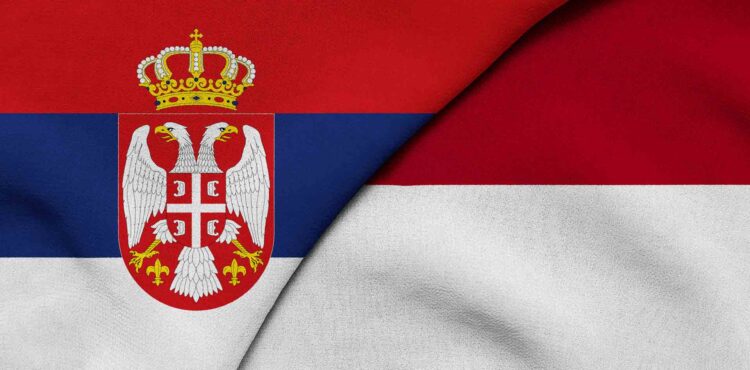CONQUERING THE VOLCANOES OF INDONESIA Nusantara flag on volcanic peaks of Indonesia
A group of hikers and mountaineers of Belgrade Mountaineering Club “Zeleznicar” conquered, for the second time, the peaks of several volcanoes in Indonesia. Just like the first time in 2010, the group aimed to climb the volcano Merapi (2,911 meters), the most active and perhaps the deadliest one in Indonesia, located on the central island of Java. The last eruption of Merapi was recorded in the period October-December 2010. After that, they went on Semeru (3,676 m), the highest mountain peak on Java that has small periodic “eruptions” ejecting ashes and pebbles every 20 to 30 minutes.
In the end they conquered the volcano Rinjani (3,726 m), the highest peak on the island of Lombok to the east of the country, which also included the descent to the lake of Anak (2,000 m), a climb to the edge of the caldera, the volcanic crater (2,700 m) and pass through the rain forest to Senaru (600m).
The group included 13 hikers from Serbia and one from Macedonia. The tour leader was Zoran Filipovic from Mountaineering club “Zeleznicar.”
While climbing and conquering the volcanic peaks of Indonesia in August and September, the mountaineers took photos of themselves holding the flag of the Association of Serbian- Indonesian Friendship “Nusantara”.
The mountaineers will share their exciting impressions from this unusual journey at one of the following presentation in the series of lectures organized by the Belgrade City Library and “Nusantara” Association on the occasion of the tenth anniversary of the founding of the Association.
The Group had the following route:
Java – Yogyakarta (Merapi volcano, the Buddhist temple of Borobudur, Prambanan Hindu Temple) – Malang – Ranu Pane (Semeru volcano) – Bromo volcano – Cemoro Lawang.
Bali
Lombok – Rinjani volcano, Segara Anak lake, Sendang Gile and Tiu Kelep waterfalls, Gili Islands, Kuta
– Merapi (2911m) the conquest started from Selo (1500m) on August 22.
– Semeru Trekking (2 days), starting from Ranu Pane (2100 m) to Kalimati camp (2700 m) and from there to Semeru (3676 m). The peak was conquered on August 26.
– Rinjani Trekking (3 days) starting from Sembalun (1100 m) to the camp at 2700 m. Early in the morning (September 3) climbing to the top of Rinjani (3726 m) and descend to Anak lake (2000 m) on the same day. Next day, a climb to the edge of the caldera (2700 m) and descend through the rainforest to Senaru (600 m).
The peaks were conquered by the following mountaineers:
Merapi – August 22, 2013 – Zorka Dulic, Aleksa Radovanovic, Elena Cickovski, Igor Bajic, Milica Bajic, Dejan Milicevic, Renata Relic, Mihajlo Dangubic, Jasna Ivkovic, Romana Popovic and Zoran Filipovic;
Semeru – August 26, 2013 – Milica Bajic, Igor Bajic , Elena Cickovski and Zorka Dulic;
Rinjani – September 9, 2013 – Milica Bajic, Igor Bajic, Elena Cickovski and Dejan Milicevic.
The mountaineers Vera Stojanovic, Ivana Lukovic and Jelena Djurdjulov also took this challenge.
The authors of images are Zorka Dulic, Elena Čičkovski, Dejan Milicevic, Igor Bajic.
Indonesia is located on the “Ring of Fire”, area surrounding the Pacific Ocean, prone to frequent earthquakes and volcanic eruptions. Therefore, the largest archipelago in the world is dominated by volcanoes formed due to the fault zone between the Eurasian and Indo-Australian Plate. Indo-Australian Plate sliding under the Eurasian Plate causes enormous shakes along the zone and sometimes explosive discharges from the numerous volcanoes.
In 2012, 127 out of 400 volcanoes in Indonesia were active in the area inhabited by five million people. Indonesia is the fourth most populated country in the world with nearly 250 million inhabitants.
The two most intense eruptions in modern history occurred precisely in Indonesia. The 1815 eruption on Mount Tambora on the island Sambava, east of Java, killed 92,000 people, the largest number recorded in the history. The explosion could be heard on the remote island of Sumatra, more than 2,000 kilometres to the west, a large volcanic ash cloud could be seen even in such remote places such as the north island of Borneo and Sulawesi, Java and the archipelago in north-eastern Maluku islands.
The 1883 eruption of Krakatau killed 36,000 people and is thought to have produced the loudest sound ever heard in history. It was heard as far as 4,800 km away from the epicentre. The explosion shock waves were recorded by barographs worldwide. The eruption of Krakatau had another global influence, gave great impetus to the study of the causes and conduct of the volcano, which led to the modern theory of tectonic plates and continents moving apart.
Super volcanic eruption in Lake Toba, in the central part of Sumatra, is estimated to have occurred 74,000 years ago and was one of the factors causing the world’s climate change. It is the largest recorded explosive eruptions on Earth within the last 25 million years.
According to Toba catastrophe theory, the eruption resulted in six years of volcanic winter; the explosion killed most of the people who lived at the time; it is believed to have created a bottleneck in human population (sudden decrease in the population) in central and Eastern Africa and India that has affected the genetic structure of people around the world.
The last major eruption in Indonesia took place in October 2012, when the Mount Lokon in northeast Indonesia spewed lava and ash.
http://www.politika.rs/rubrike/spektar/zivot-i-stil/Osvojili-tri-vulkana-u-Indoneziji.lt.html
http://www.b92.net/putovanja/zanimljivosti.php?yyyy=2013&mm=10&dd=18&nav_id=766572
http://www.blic.rs/Vesti/Reportaza/413215/Beogradjani-osvojili-tri-vulkana
http://kurir.org/zabava/d272788/beogradjani-osvojili-tri-vulkana
http://evroazija.info/planinarski-klub-zeleznicar-i-nusantara-na-vulkanskim-vrhovima-indonezije/
http://vesti.krstarica.com/zivot/osvojili-tri-vulkana-u-indoneziji/
http://www.naslovi.net/search.php?q=indonezija
http://www.smedia.rs/ona/putovanja/vest/141602/b92-Osvojili-tri-vulkana-u-Indoneziji.html
http://www.glas-javnosti.rs/aktuelne-vesti/2013-10-15/osvajanje-vulkana-indonezije
http://www.medias.rs/najnovije-vesti/osvojili-tri-vulkana-u-indoneziji/













